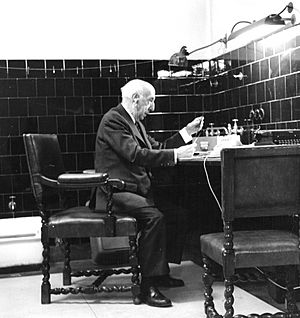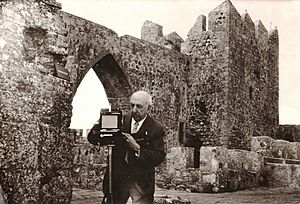José Ortiz-Echagüe facts for kids
Quick facts for kids
José Ortiz-Echagüe
|
|
|---|---|

José Ortiz-Echagüe in his home laboratory
|
|
| Born |
José Ortiz-Echagüe Puertas
2 August 1886 Guadalajara, Spain
|
| Died | 7 September 1980 (aged 94) Madrid, Spain
|
| Nationality | Spanish |
| Known for | Photography |
| Movement | Pictorialism |
| Spouse(s) | Carmen Rubio |
José Ortiz-Echagüe (born August 2, 1886, in Guadalajara, Spain – died September 7, 1980, in Madrid) was a very talented Spanish person. He was an engineer, a pilot, a businessman, and a famous photographer! He even started big companies like CASA, which makes airplanes, and SEAT, a car company. He was also a special helper to King Alfonso XIII.
Contents
About José Ortiz-Echagüe
José Ortiz-Echagüe was born in 1886. His father, Antonio Ortiz, was a military engineer. José was one of six children. When he was three, his family moved to Logroño, where he grew up. He always felt a strong connection to this region.
José's older brother, Antonio, became a well-known painter. José first wanted to be a painter too. But when he was 12, he got his first camera from an uncle. It was a Kodak camera, and it changed everything! He started taking photos and discovered his artistic talent.
In 1903, he took a photo called 'Sermon en la aldea' (Sermon in the Village). The next year, it won first prize at an exhibition! A Spanish photo magazine even wrote about his work.
Becoming an Engineer and Pilot
Even though he loved photography, José followed his father's wishes and joined the Academy of Military Engineers in Guadalajara in 1903. After finishing his training, he worked in the Balloon unit during the Spanish-Moroccan War.
He became one of the first Spanish people to get a pilot's license in 1911. In 1914, he and Captain Herrera were the first to fly over the Strait of Gibraltar. In 1916, he married Carmen Rubio, and they had eight children.
Building Companies
José Ortiz-Echagüe was also a brilliant businessman and engineer. In 1913, he tried to fly a plane from Paris to Madrid. The plane caught fire, but he saved himself and the engine! He then used that engine to build a new plane in Morocco.
In 1923, he started an airplane manufacturing company called CASA in Seville. Today, its successor, EADS CASA, helps build Airbus planes.
Later, in 1950, he founded SEAT, the first Spanish car company. He was its first president and later became its Honorary lifetime President. SEAT is now part of the Volkswagen group.
José was always a pioneer. In 1959, at 72 years old, he flew as a co-pilot in an F-100 Sabre jet. He became the oldest person to fly at supersonic speed (faster than the speed of sound)!
José Ortiz-Echagüe's Photography
José Ortiz-Echagüe believed Spain needed to modernize. But he also knew that this modernization could make traditional ways of life disappear. He wanted to use his camera to capture and preserve this cultural heritage before it changed.
His Unique Style
José Ortiz-Echagüe is one of Spain's most famous photographers. In 1935, 'American Photography' magazine called him one of the top three photographers in the world! This is amazing because photography was just his hobby, something he did in his free time.
His style is often linked to a movement called pictorialism. This style made photos look more like paintings. He focused on showing the unique features of people, their customs, and traditional clothes, as well as landscapes. He used special techniques during photo development to create a painterly effect. He always used gum bichromate and coal printing techniques.
How He Made His Photos
From 1898, José took thousands of photos, all in black-and-white. He used a special printing method similar to carbon printing, called 'carbón fresson'. This technique was popular when he was young, but it soon became old-fashioned. However, he kept using it throughout his career. This gave his photos a special hue (color tint) and strong contrast, making them easy to recognize.
This method was very difficult and needed a lot of patience and skill. It involved a special paper with a thin layer of gelatin and black pigment. The parts of the image that got less light stayed soft, while the parts that got more light became hard. Then, he would wash the paper, and the soft parts would dissolve, revealing white areas, while the hard parts kept the pigment, creating black areas.
What made this technique special was that he could retouch the wet print with brushes and cotton swabs. This gave him a lot of artistic freedom. He loved this method because it allowed him to control the final look, gave richer tones, and made the photos last longer.
His Cameras
José received his first camera, a Kodak, when he was 12. It took small photos (8 × 6.6 cm). Three years later, he got a 'Photo Esphère' camera that used glass plates (9 x 12 cm). From 1903 to 1909, he used a folding camera and a larger travel camera. For his famous photos of traditional costumes, he used a 13 × 18 cm travel camera with a special lens. In 1934, he used a reflex camera for landscapes. In his later years (until 1970), he used a Linhof Technika and a Graflex Speed Graphic camera, which was popular with press photographers.
His Photo Collections
Ortiz-Echagüe organized his photos into several books:
- 'Tipos y Trajes' (Characters and Outfits) (1930): This book shows Spanish people in their traditional clothes, with deep human expressions.
- 'España, Pueblos y Paisajes' (Spain, Peoples and Landscapes) (1939): This collection explores the contrast between different lands and people in Spain.
- 'España Mística' (Mystical Spain) (1943): This series focuses on religious communities and traditions like pilgrimages. The portraits of monks remind people of famous painters like Zurbarán or El Greco.
- 'España, Castillos y Alcázares' (Spain, Castles and Palaces) (1956): This book features beautiful photos of Spanish castles.
He also had two other important series:
- 'Marruecos' (Morocco): These photos were taken between 1909 and 1916 when he was a military engineer in Morocco.
- 'Fotos familiares' (Family photos): These are high-quality portraits of his family.
His photos are admired for their beauty, delicate settings, and the respect he showed for the people he photographed. His work continues to fascinate people today.
His photos have been shown in many exhibitions around the world. Most of his work is kept at the 'Legado Ortiz-Echagüe' (Ortiz-Echagüe Legacy) at the University of Navarra. This collection has about 1,000 original prints and over 20,000 negatives. The 'Museo del Traje' (Museum of Outfits) in Madrid also has a good collection of his 'Tipos y Trajes' photos.
Major Exhibitions
- In 1929, his photos were shown in Berlin, and a book called 'Spanische Köpfe – Bilder aus Kastilien, Aragonien und Andalusien' was published.
- In 1960, the Metropolitan Museum of Art in New York City held a big exhibition called 'Spectacular Spain'. It featured eighty of Ortiz-Echagüe's photographs alongside works by artists like Goya.
- In 1998, the University of Navarra organized a large exhibition of his photos, which traveled to many museums, including the National Art Museum of Catalonia, the Hôtel de Sully in Paris, and the Reina Sofía National Art Museum in Madrid, which had over 150,000 visitors!
See also
 In Spanish: José Ortiz Echagüe para niños
In Spanish: José Ortiz Echagüe para niños


